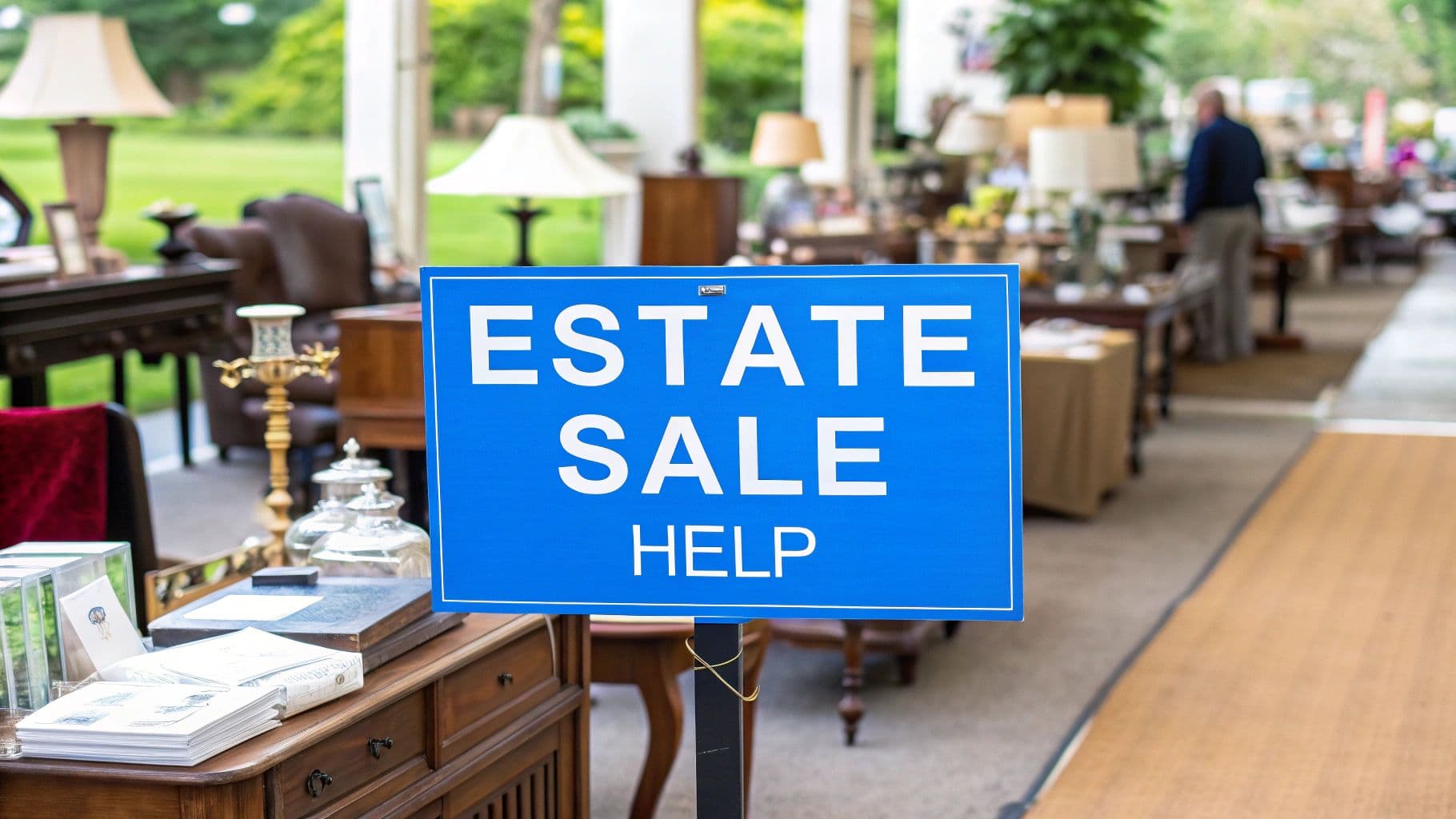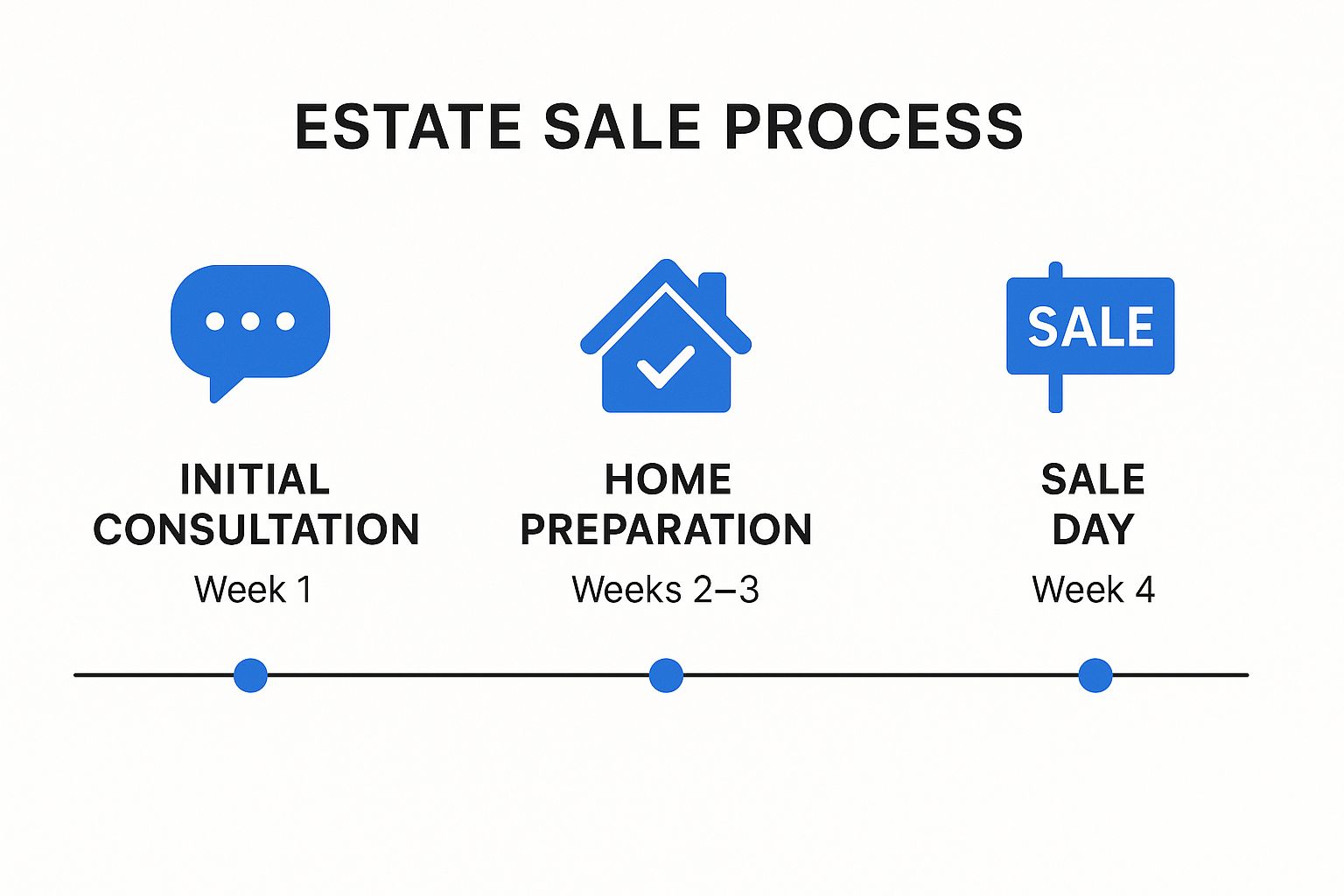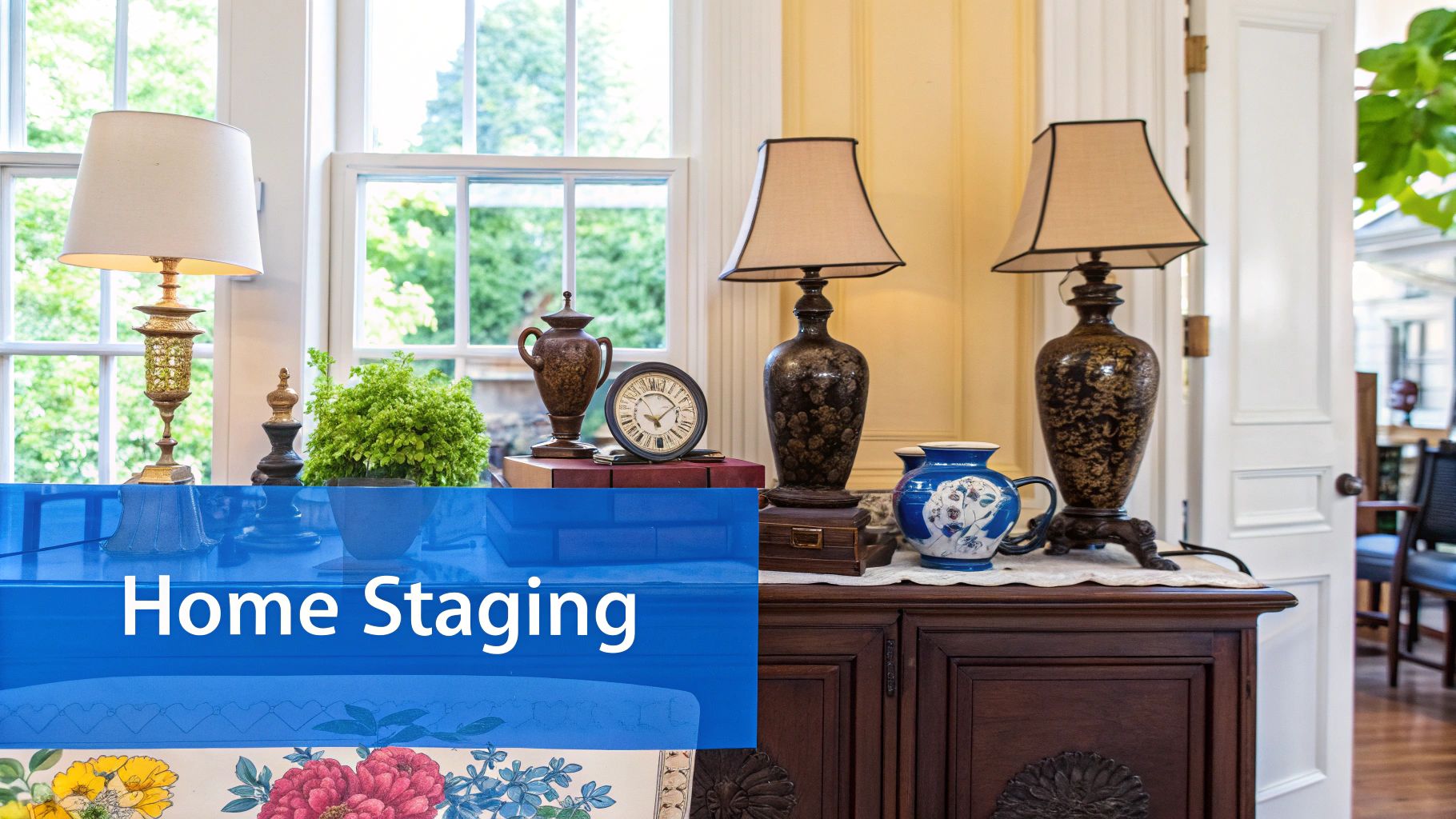Estate Sale Help A Practical DIY Guide

Feeling overwhelmed by the task of settling a loved one's home is completely normal. The secret is breaking that monumental job into smaller, more manageable steps. If you can get the first few things right—defining your goals, setting a timeline, and getting a rough inventory—you'll build a solid foundation for a successful, structured event.
Your First Steps for a Successful Estate Sale
Jumping into an estate sale without a plan is a recipe for chaos. It’s so much more than just slapping price tags on things; think of it as a project with distinct phases. Getting these initial steps right sets the tone for everything that follows, saving you from last-minute headaches and keeping you firmly in the driver's seat.
We're seeing more and more families navigate this process, and it’s no surprise why. With around 10,000 baby boomers turning 65 every single day in the U.S., a huge number of households are downsizing or transitioning. This has led to a major increase in sales where families need to liquidate thousands of items, from everyday furniture to cherished collections.
What's Your Primary Goal?
Before you even think about sorting or pricing, you need to answer one simple but crucial question: What is the most important outcome of this sale? Your answer will shape every single decision you make from here on out.
Is your main goal to maximize profit? If so, you’ll need to put more time into researching, careful pricing, and marketing to get top dollar. Or, is the real priority to clear the house quickly to meet a deadline, like an impending home sale? This means focusing on efficiency, even if it means not getting the absolute highest price for every last item. There's no wrong answer, but knowing your priority upfront makes all the difference.
Create a Realistic Timeline
A well-thought-out timeline is your best friend in this process. When you rush, you make mistakes—like accidentally underpricing a valuable antique or forgetting to promote the sale. Most estate sales take several weeks to prepare for properly, so mapping it out gives you a clear path to follow.
To give you a better idea, here’s a look at a typical four-week plan that takes you from the initial thought to sale day.

As you can see, the heavy lifting happens in the first three weeks. Getting that work done early is what makes the final sale week run smoothly.
To help you stay on track, we've put together a sample planning timeline.
Sample Estate Sale Planning Timeline
This table breaks down the key tasks and provides a recommended timeframe to keep your sale preparation organized and stress-free.
| Phase | Tasks | Recommended Timeframe |
|---|---|---|
| Initial Planning | Define goals, set a budget, create a timeline, conduct a broad inventory. | 4-6 weeks out |
| Sorting & Decluttering | Sort items into Keep, Sell, Donate, and Discard piles. Remove personal documents. | 3-4 weeks out |
| Research & Pricing | Research values of key items. Price everything for the sale. | 2-3 weeks out |
| Staging & Photography | Arrange items for the sale. Take clear, well-lit photos for your online catalog. | 1-2 weeks out |
| Marketing & Promotion | Launch your online auction. Promote the sale on social media and to local groups. | 1 week out |
| Sale & Pickup | Manage the live sale. Coordinate a single, organized pickup day for buyers. | Sale Day / Week |
Following a structured schedule like this prevents last-minute panic and ensures you haven't missed any crucial steps.
Get a Handle on Your Inventory
The last piece of the foundation is figuring out what you’re actually working with. Don’t worry, this isn't the time to create a detailed, item-by-item spreadsheet. Just walk through the home and start mentally grouping things into broad categories.
An initial inventory isn't about counting spoons. It's about understanding the scope of your project. Grouping items into categories like 'garage tools,' 'kitchenware,' 'vintage clothing,' and 'fine china' helps you see the big picture and identify areas that will require more attention.
This high-level pass-through will help you:
- Spot the Winners: Quickly identify high-value items like art, antiques, or jewelry that might need a professional appraisal.
- Estimate the Workload: A house filled with small knick-knacks is a very different project than one with mostly large furniture.
- Plan Your Staging: You can start visualizing how you’ll group and display items for the sale itself.
By taking these three initial steps—setting goals, making a timeline, and doing a quick inventory—you’re building the framework for a successful, less stressful sale. For a complete, step-by-step guide, be sure to grab our comprehensive estate sale checklist to make sure nothing falls through the cracks.
How to Price Your Items to Actually Sell

Here's where the rubber meets the road. Pricing is single-handedly the part of a DIY estate sale that can make it a roaring success or a total flop. I've seen it happen time and time again—it's the one area where people most often ask for help.
If you price everything too high, you’ll be left with a house full of stuff when the sale is over. But price too low, and you're practically giving away money. The real goal is to hit that "fair market value" sweet spot.
This takes a critical mental shift. You have to learn to separate what an item meant to your family from what it’s worth to a buyer. That chipped coffee mug Grandpa used every morning? Priceless to you, but to a stranger, it’s a 50-cent mug. Realistic pricing is all about what someone is willing to pay for it today.
Finding Real-World Comparables
Your best friend in the pricing game isn't guesswork; it's data. You need to see what similar items have actually sold for recently. The easiest place to start is eBay.
But here’s the trick: don’t look at what people are asking for. You need to filter your search for "Sold Items." This is the gold standard because it shows you what real people have paid in the last few weeks or months—a true pulse on market demand. A quick search for a vintage Pyrex "Friendship" pattern casserole dish will tell you exactly what buyers are paying for that item, in that specific condition, right now.
- For Everyday Goods: This method is perfect for furniture, standard kitchenware, power tools, and most electronics.
- For Collectibles: It's absolutely essential for things like comic books, vinyl records, and trading cards where value fluctuates.
- Condition is King: Be brutally honest. Always compare your item's condition—whether it’s "new in box," "lightly used," or "has a chip"—to the ones in the sold listings to get an accurate price.
Grouping and Bundling for Value
Not every little trinket needs its own price tag. In fact, trying to price every single kitchen utensil is a fast track to burnout. For lower-value goods, bundling is a brilliant strategy that clears out clutter fast and makes shoppers feel like they're getting a great deal.
Get creative and make some appealing "lots":
- A "baking essentials" box with measuring cups, a rolling pin, and cookie cutters for one price.
- A bucket filled with assorted hand tools from the workbench.
- A bag stuffed with craft supplies like yarn, fabric scraps, and needles.
Bundling is a powerful psychological tool. It transforms items that might not sell individually into a convenient, must-have package. A shopper might hesitate to buy one book for $2, but they'll happily grab a "Bag of Beach Reads" for $10.
This approach not only moves more inventory but also saves you an incredible amount of time. You don't have to price hundreds of tiny items, and your buyers feel like they've scored. To get even more ideas, check out our complete estate sale pricing guide for a deeper dive.
Knowing When to Call a Professional
While online research works for most things, some items are just too risky to guess on. You could accidentally undervalue a piece by thousands of dollars without even knowing it. For certain categories, getting some professional estate sale help is a wise investment, not just an expense.
It's time to pause and seek an expert opinion for:
- Fine Art: Anything that is signed or from a listed artist.
- Jewelry and Watches: Especially items with precious metals, gemstones, or high-end brand names.
- Antiques: Furniture, pottery, or decor that you believe is over 100 years old.
- Specialized Collections: Think rare coins, stamps, or military memorabilia.
A certified appraiser provides a formal valuation, which is essential for your own peace of mind and for getting the true value. For these high-ticket items, an appraiser's fee is a small price to pay for what could be a significantly higher return.
Staging the Home for Maximum Buyer Appeal

How you present your items and the home itself will absolutely make or break your sale. This isn't about professional interior design—it's about temporarily turning a private home into an effective, welcoming retail space. A cluttered, messy house feels overwhelming and instantly devalues everything in it.
On the flip side, a clean, well-organized home gives buyers confidence. It encourages them to stick around, look closer, and ultimately spend more. It’s the difference between a chaotic rummage sale and a curated shop, and that extra effort pays off directly in your pocket.
Create Shoppable Departments
First things first: group similar items together. You want to create logical "departments" throughout the house so people can easily find what they're looking for. This simple step prevents shopper frustration and makes sure they see all the fantastic things you have to offer.
- Garage & Workshop: Pull together all the power tools, hand tools, gardening equipment, and hardware. A workbench or sturdy shelves are perfect for display.
- Kitchen: Get all the glassware, dishes, small appliances, and cookware onto the countertops and kitchen table.
- Bedrooms & Closets: Use these spaces for clothing, linens, and accessories. If you can, hang clothes on portable racks. Fold towels and sheets neatly on the beds.
- Living Areas: This is where you'll showcase furniture, home decor, books, and electronics. Arrange them so people can easily walk around and inspect each piece.
When you organize this way, a buyer looking for tools knows to make a beeline for the garage, while someone hoping to find vintage glassware can focus on the kitchen.
Design a Clear Traffic Flow
Once your departments are set, you need to think about how people will move through the house. This is a crucial step that many first-timers miss. A bad layout creates frustrating bottlenecks, especially in hallways and small rooms.
Your main goal is to create a single, clear path that guides shoppers through the entire home. You can use furniture or even temporary barriers to gently direct the flow. Think about creating aisles with tables that lead from one room to the next, ensuring every "department" gets seen. And don't forget to block off any unsafe areas or rooms not part of the sale with tape and clear signs.
A well-planned traffic flow does more than just prevent a human traffic jam. It acts as a silent tour guide, leading customers past every single item for sale and dramatically increasing the chance of impulse buys. It makes the whole experience feel professional and controlled.
Highlight Your Best Items
Let's be honest, not every item is a star. You need to use some simple staging tricks to draw attention to your most valuable and appealing pieces. A little extra effort here can seriously boost the final selling price of your key merchandise.
Here’s how to make your best stuff shine:
- Use Good Lighting: Open every curtain and blind. Let that natural light pour in! For valuable items stuck in darker corners, like a painting or a china cabinet, aim a simple lamp at them for a spotlight effect.
- Create Clean Displays: Don't just dump things on a table. Throw a clean tablecloth over a folding table to create a polished, uniform look. More importantly, give items some breathing room. An uncluttered display always looks more valuable.
- Position Key Pieces: That beautiful mid-century modern credenza shouldn't be hiding in a spare bedroom. Put your high-demand items in highly visible, high-traffic areas. Make them a focal point that draws people into a room.
This level of thoughtful presentation is the kind of estate sale help that builds buyer trust and translates directly into higher profits for you.
Modern Marketing to Attract Eager Buyers
Gone are the days when a simple yard sign and a classified ad would cut it. If you want a crowd of genuinely interested buyers lining up for your sale, you need to think like a modern marketer. Today, effective estate sale help isn't just about organizing items—it's about mastering digital promotion to reach the right people.
This means shifting your focus online, right where today’s buyers are already searching for sales. A smart digital strategy is what makes all your hard work staging and pricing actually pay off, ensuring a motivated audience shows up ready to buy.
Master Your Visuals and Descriptions
Your photos and item descriptions are your most powerful sales tools. Period. Blurry, dark pictures or lazy, vague descriptions will kill interest before it even gets started. You want to make someone look at your listing and feel like they have to be at your sale.
Photography Tips for Real Impact:
- Let the Light In: Open every curtain and take your photos during the day. Ditch the harsh camera flash; it just creates glare and unflattering shadows that can make great items look cheap.
- Showcase the Stars: Your most valuable or unique items deserve their own close-up shots. For everything else, take clear, well-lit group photos of your organized "departments."
- Tell a Visual Story: Don't just snap a picture of a chair against a blank wall. Stage it in a cozy reading corner. Help people instantly visualize your items in their own homes.
Once you have stunning photos, you need descriptions to match. "Brown desk" is a non-starter. Instead, try something like, "Vintage solid oak roll-top desk with built-in organizers and a smooth writing surface, perfect for a home office." Always mention brands, materials, dimensions, and the item's condition to build trust and confidence.
Choose the Right Digital Channels
To attract a diverse crowd of buyers, you need to cast a wide digital net. Putting all your eggs in one basket just limits your reach. A multi-channel approach is the secret to connecting with everyone from local bargain hunters to serious collectors.
The estate sale industry has changed dramatically with technology. By 2025, it's estimated that 30%-40% of estate sale companies will be using online platforms and virtual tools. This shift has been shown to boost final sales prices by 10%-15% on average simply by connecting sellers with a much broader, more competitive group of buyers.
Here’s a glimpse at how the pros list their sales on major platforms.
This screenshot from EstateSales.net perfectly illustrates the modern standard. Listings lead with large, appealing photos and put crucial details like dates and location front and center. This visual-first format is exactly what you should aim for to grab a buyer's attention.
Zero In on Local and Niche Buyers
While major listing sites are your foundation, don't sleep on the power of local online communities. This is where you find highly engaged buyers right in your own backyard.
- Facebook Marketplace: A true powerhouse for both promoting your overall sale and moving individual items. Its massive user base makes it an essential tool.
- Local Community Groups: Hop on Facebook and search for your neighborhood, town, or local "buy and sell" groups. Posting here is like putting a digital flyer in front of thousands of your neighbors.
- Specialty Forums: Got a huge collection of vintage Star Wars toys or antique tools? Find online forums dedicated to those hobbies. A quick post there can attract passionate enthusiasts.
Your marketing plan should be a hybrid. Use broad platforms like EstateSales.net or DIYAuctions to reach the masses, then dive into niche communities to attract passionate collectors who will gladly pay a premium for the things they love.
This targeted strategy makes sure your most valuable items get seen by the people who will appreciate—and pay for—their true worth. For a deeper dive, our complete guide on how to advertise an estate sale offers a full step-by-step plan.
Running the Sale and Handling the Aftermath

This is it—the culmination of all your planning and preparation. Sale days are high-energy and can get a little chaotic, but with a solid game plan, you’ll be able to manage the flow of shoppers, maximize your earnings, and handle the final clean-out like a pro.
First things first: you can't run a sale alone. Seriously. You need at least one or two friends or family members on hand to act as your support crew. Their job is to be an extra set of eyes on valuable items, help customers haul out larger purchases, and give you a much-needed break. A great setup is to have one person "float" through the house, keeping an eye on things, while another helps you at the checkout station.
Mastering the Checkout and Negotiations
Your checkout station should be a simple, secure hub. All you need is a card table near the main exit, equipped with a lockable cash box that has plenty of small bills and change. To make transactions smoother and appeal to modern buyers, you absolutely need to accept digital payments. Services like Venmo, Zelle, or Square are easy to set up and allow for the quick, secure payments many shoppers now expect.
Negotiation is just part of the game at an estate sale, so expect it. You're going to get lowball offers, especially on the first day. Don't take it personally; it’s just how these things work.
Expert Tip: Have a firm but polite response ready for those low offers. Something as simple as, "I appreciate the offer, but I can't go that low today. Feel free to check back tomorrow," works wonders. It keeps the interaction positive while you hold your ground on pricing.
As the sale moves along, your pricing strategy needs to get more flexible. A common and highly effective tactic is offering a big discount on the final day.
- Final Day Strategy: For the last few hours of the sale, announce that most items are 50% off. This creates a powerful sense of urgency and helps clear out a huge amount of your remaining inventory. It’s always better to get half price for something than nothing at all.
The Post-Sale Clean-Up Plan
Once the last shopper leaves, you’ll be looking at whatever is left. This is where having a clear post-sale plan is critical. The goal is to leave the property completely empty and clean, ready for its next chapter, whether that's being sold or rented.
The sheer scale of estate liquidations highlights their economic importance. With global residential real estate markets projected to top $5.3 trillion by 2026, the demand for services that efficiently clear out properties is only growing. You can explore more about global real estate trends to see how these dynamics impact the market.
To deal with the leftovers, a multi-pronged approach usually works best.
Options for Unsold Items After the Sale
When the sale is over, you still need to clear the house. This table breaks down your main options for handling everything that didn't sell, helping you choose the best path forward.
| Method | Pros | Cons |
|---|---|---|
| Charity Donation | It's tax-deductible, feels good, and many charities offer free pickup. | Not all items may be accepted; you get no cash value for the items. |
| Consignment Shops | You have the potential to earn more money on high-end furniture or decor. | Shops take a significant commission; it can take months to sell. |
| Final Clean-Out Service | This is the fastest way to empty the house; they handle all labor and disposal. | It can be expensive; you usually get little to no money for the remaining items. |
Often, the best strategy is a mix of all three. You could take a few high-value pieces to a local consignment shop, schedule a charity pickup for the bulk of the good-quality household items, and then hire a junk removal service for whatever is left. This approach can bring in a little extra income while making sure the property is completely cleared out on schedule.
Answering Your Top Estate Sale Questions
Diving into the world of estate sales for the first time can feel like a crash course in a new field. You're suddenly dealing with questions about fairness, legality, and just making the right call for your family. That's completely normal, and asking these questions is the most important part of the process.
Getting clear, straightforward answers is exactly what you need to move forward. Below, we've tackled the most common questions we hear from families just like yours, offering our experienced take to help you act with confidence.
When Should I Hire a Pro vs. Do It Myself?
The classic dilemma: go with a full-service professional company or take a DIY approach? It really boils down to a trade-off between time and control versus cost. Taking a hard look at your personal situation is the only way to know what’s right.
A professional estate sale company is an all-in-one solution. They handle the sorting, pricing, staging, marketing, and staffing. This can be a lifesaver if you're:
- On a tight deadline, like needing the house cleared for a real estate closing.
- Managing the sale from another city or state and can't be there in person.
- Feeling completely overwhelmed by the emotional weight of it all and just need to hand it off.
- Dealing with high-value collections like fine art, antiques, or jewelry that demand true expertise.
Of course, that level of convenience isn't free. You can expect traditional companies to charge a commission of 30% to 45% of the gross sales.
A supported DIY approach, like using a platform such as DIYAuctions, is a game-changer. It puts you in the driver's seat, allowing you to keep a much larger share of the profits—often 90% or more. This path is perfect if you have some time to invest and your primary goal is to maximize the financial outcome for the estate. You control the organization and pricing, while we handle the heavy lifting of marketing and payment processing.
What Are the Biggest Mistakes to Avoid?
It’s tough to watch a sale fall flat, and it almost always comes down to a few critical, but avoidable, mistakes. Getting these right from the start is half the battle.
The absolute biggest error we see is unrealistic pricing. It's easy to price things based on sentimental value or what they cost brand new, but that’s a surefire way to end up with a house full of unsold items. On the flip side, pricing too low means you’re just giving money away.
Another deal-breaker is poor marketing. A cardboard sign on the corner just doesn't cut it anymore. Today, serious buyers find sales online. If you don't post bright, clear photos and write descriptive listings, the right people will never even know your sale is happening.
Finally, a chaotic setup is a massive turnoff for shoppers. Nobody wants to dig through grimy piles or squeeze through cluttered, unsafe rooms. You have to create clean, organized displays and clear pathways. A bonus mistake? Not having enough help on sale days, which leads to long checkout lines, potential theft, and you being completely burned out.
Key Takeaway: A successful sale rests on three pillars: realistic pricing, modern digital marketing, and a clean, organized space. If one of these is weak, the whole effort can be undermined, slashing your final profits.
How Do I Handle Potentially Valuable Items?
This is one area where you absolutely must proceed with caution. Whatever you do, don't guess the value of items you think might be significant. The risk of selling a $5,000 painting for $50 is very, very real.
For things like signed artwork, genuine antique furniture, fine jewelry, or coin collections, a careful, multi-step process is your best bet:
- Do Some Initial Online Research. Start by searching for similar items on high-end auction sites like LiveAuctioneers or Heritage Auctions. Look for sold prices, not just listing prices, to see what things are actually fetching in the real world.
- Get a Professional Appraisal. If your research suggests an item is truly valuable, investing in a certified appraiser is non-negotiable. Their fee is a small price for the certainty it provides and can be critical for estate documentation.
- Consider a Specialized Sale. Often, the best place to sell high-ticket items isn't at the general estate sale at all. A dedicated auction house that caters to serious collectors will get your item in front of a global audience of motivated buyers willing to pay top dollar.
What Safety and Legal Issues Should I Know About?
The moment you open a private home to the public, liability has to be top of mind. Protecting both your shoppers and the estate from accidents is a non-negotiable part of the job.
First things first: call your homeowner's insurance provider. Confirm that your policy covers liability for a public event like an estate sale. Many do, but you absolutely have to verify it.
Inside the house, preventing trips and falls is priority number one.
- Clearly block off any hazardous areas—a rickety staircase, a cluttered basement, a garage full of sharp tools.
- Use bright painter's tape to mark any unexpected steps or changes in floor level.
- Make sure all walkways are completely clear of tripping hazards like cords, loose rugs, and general clutter.
On the legal side, be crystal clear with your terms. Post signs at the entrance and checkout stating your policies, like "All Sales Final," "Cash and Credit Accepted," and "Not Responsible for Accidents." If you are the executor of the will, double-check that you have the legal authority to sell the property.
And finally, keep a meticulous record of every single sale. This income can have tax implications for the estate, so a detailed ledger is essential for clean accounting.